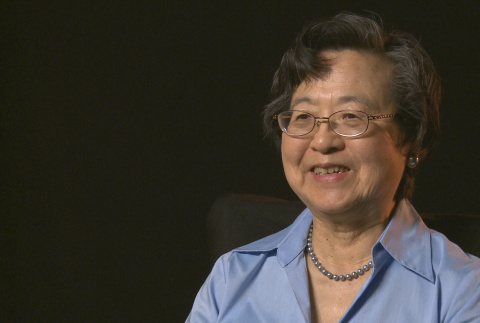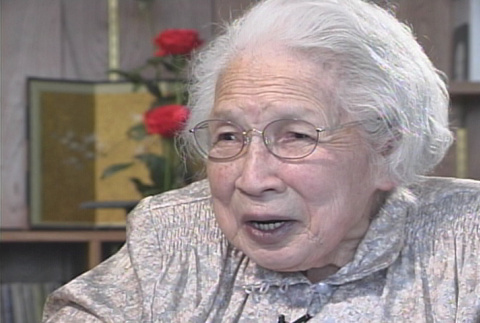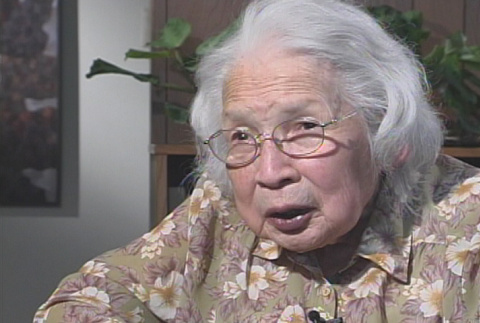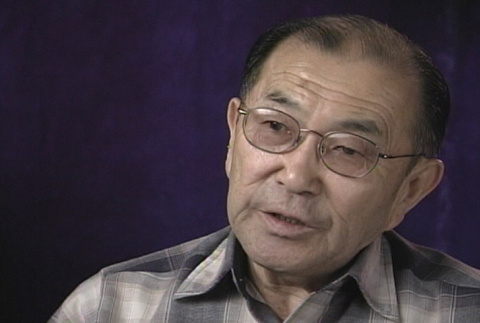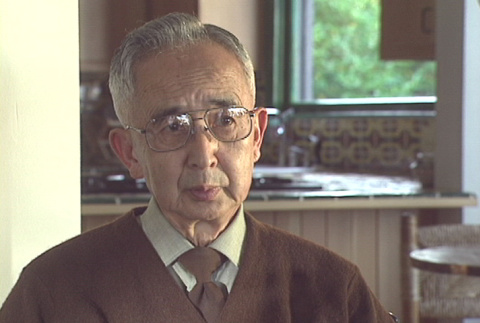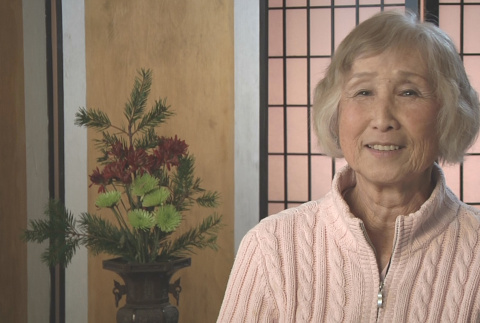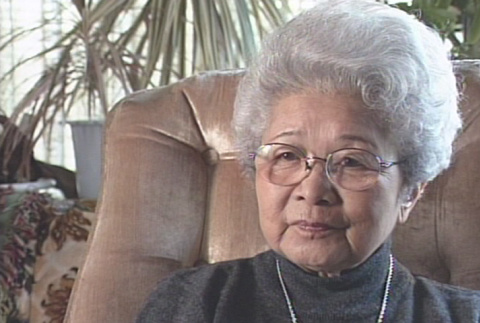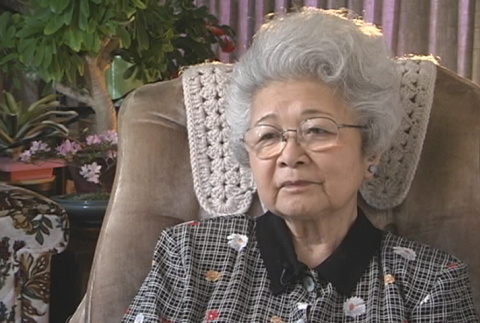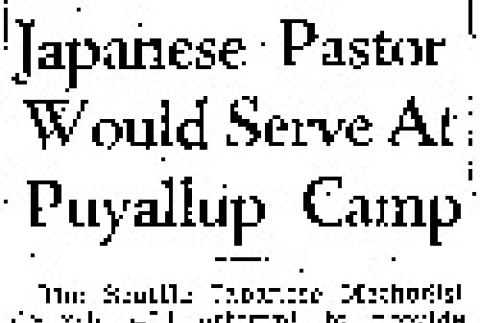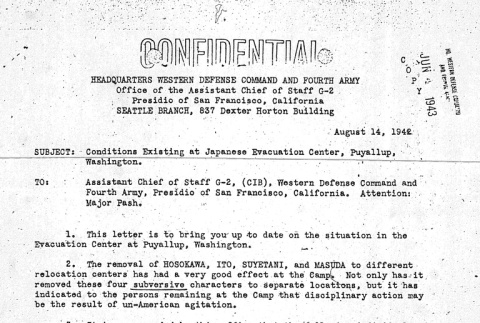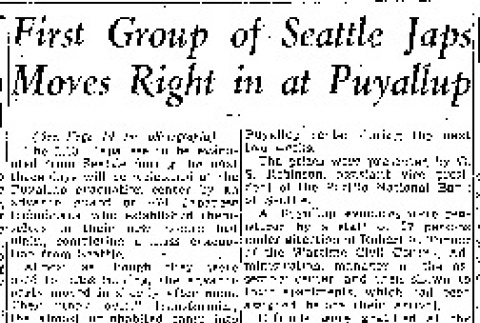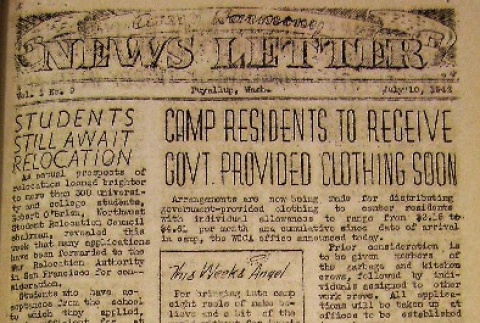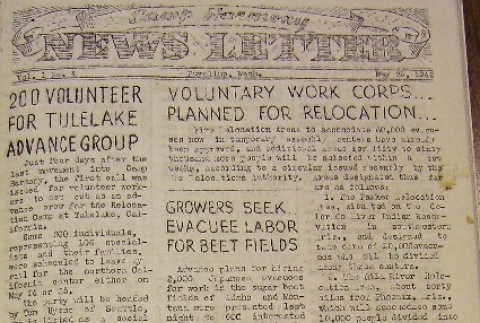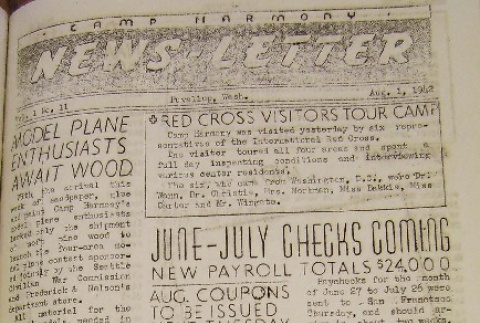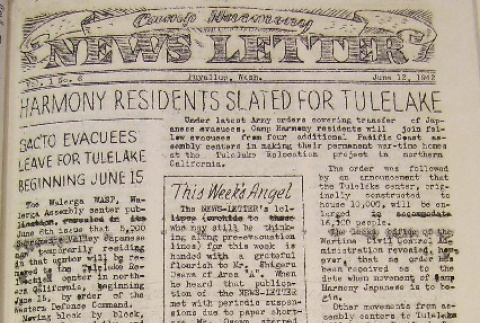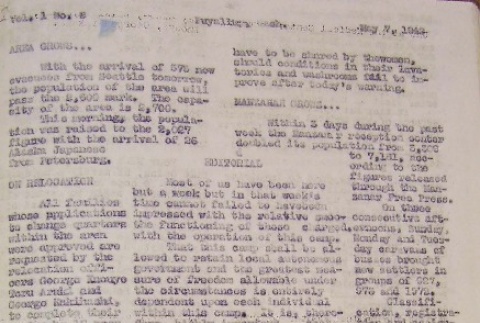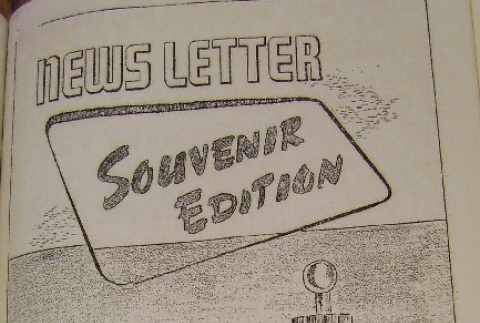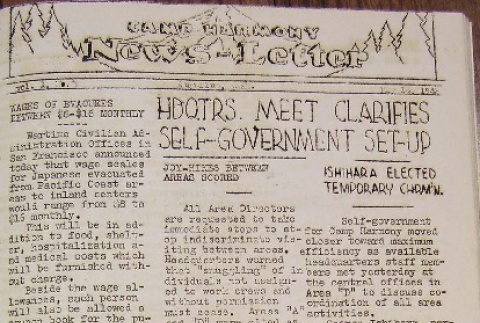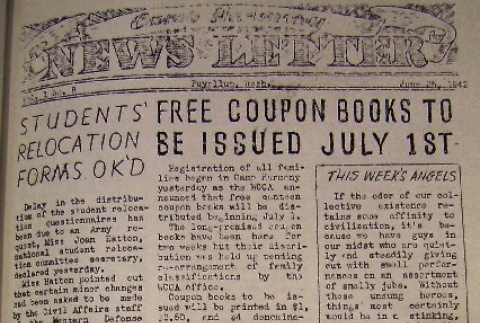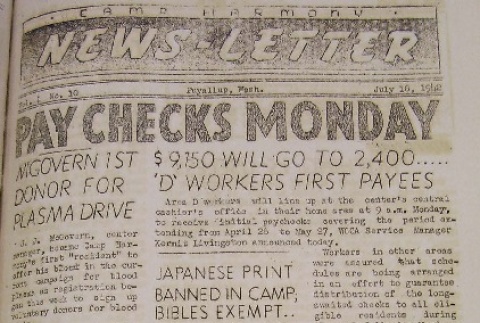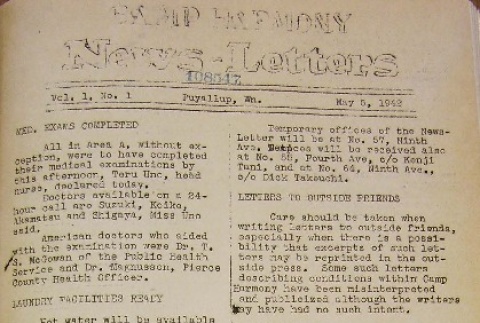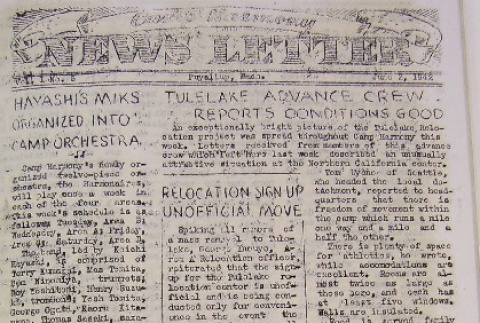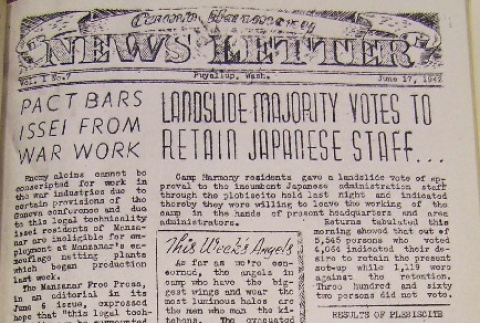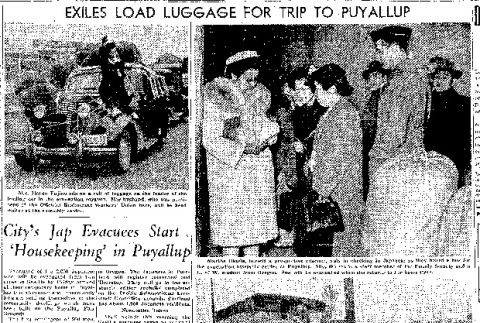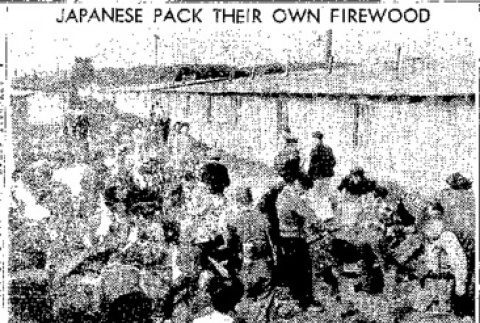323 items
323 items
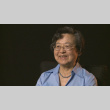
vh
Margaret Junko Morita Hiratsuka Interview (ddr-densho-1000-342)
Nisei female. Born July 22, 1928, in Seattle, Washington. Father ran a prominent hotel which was frequently patronized by visiting Japanese dignitaries. Father was picked up by the FBI on December 7, 1941. During the war, removed with family to the Puyallup Assembly Center, Washington, and the Minidoka concentration camp, Idaho. After leaving camp, moved to …
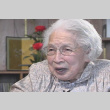
vh
Yasashi Ichikawa Interview I (ddr-densho-1000-111)
Issei female. Born 1907 in Shimonoseki, Japan. Attended school in Japan, and was encouraged by father to study English. Married a Buddhist minister and immigrated to the United States. Lived in Fresno, California, then returned to Japan for two years. Moved to Seattle, Washington, where husband was a minister at the Seattle Buddhist Temple. During World …
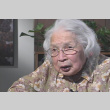
vh
Yasashi Ichikawa Interview II (ddr-densho-1000-112)
Issei female. Born 1907 in Shimonoseki, Japan. Attended school in Japan, and was encouraged by father to study English. Married a Buddhist minister and immigrated to the United States. Lived in Fresno, California, then returned to Japan for two years. Moved to Seattle, Washington, where husband was a minister at the Seattle Buddhist Temple. During World …
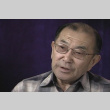
vh
John Kanda Interview (ddr-densho-1000-116)
Nisei male. Born July 10, 1925, in Seattle, Washington. Grew up in the Thomas-Auburn area of Washington. Following Executive Order 9066, family was removed to the Pinedale Assembly Center, then to Tule Lake concentration camp in California. Later transferred to Minidoka concentration camp, Idaho. Volunteered as a replacement for the 100th/442nd Regimental Combat Team and trained …
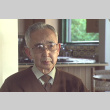
vh
Shosuke Sasaki Interview (ddr-densho-1002-2)
Issei male. Born 1912 in Yamaguchi ken, Japan. Immigrated to United States in 1919. Lived in Pomeroy, Washington, and Seattle, Washington, before World War II. Incarcerated at the Puyallup Assembly Center, Washington and the Minidoka concentration camp, Idaho. Resettled in New York. As a member of the Newspaper Guild, led effort to eliminate pejorative use of …
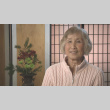
vh
Etsuko Ichikawa Osaki Interview (ddr-one-7-56)
Nisei female. Born February 19, 1931, in Fresno, California. Family moved to Seattle, Washington, where father became minister of the Seattle Buddhist Temple. During the war, removed to the Puyallup Assembly Center, Washington, and Minidoka concentration camp, Idaho. Transferred to the Crystal City internment camp, Texas, to be reunited with father, who was arrested by the …
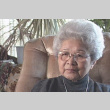
vh
Yone Bartholomew Interview II (ddr-densho-1000-5)
Nisei female. Born July 15, 1906, in Bedderavia, California. Was given for adoption by her parents to a couple who could not have children of their own. Grew up on a family farm and was one of the oldest Nisei in the Santa Barbara area of California. Incarcerated at the Puyallup Assembly Center, Washington, and Minidoka …
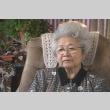
vh
Yone Bartholomew Interview I (ddr-densho-1000-4)
Nisei female. Born July 15, 1906, in Bedderavia, California. Was given for adoption by her parents to a couple who could not have children of their own. Grew up on a family farm and was one of the oldest Nisei in the Santa Barbara area of California. Incarcerated at the Puyallup Assembly Center, Washington, and Minidoka …
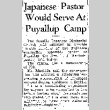
doc
Japanese Pastor Would Serve at Puyallup Camp (April 22, 1942) (ddr-densho-56-764)
The Seattle Daily Times, April 22, 1942, p. 14
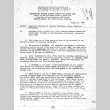
doc
Memo regarding "agitators" at Puyallup Assembly Center (ddr-densho-67-108)
Lists "subversive" activities and who should be transferred.
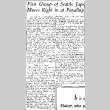
doc
First Group of Seattle Japs Moves Right in at Puyallup (April 29, 1942) (ddr-densho-56-778)
The Seattle Daily Times, April 29, 1942, p. 4
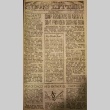
doc
Puyallup Camp Harmony News-Letter Vol. I No. 9 (July 10, 1942) (ddr-densho-194-9)
Selected article titles: "Students Still Await Relocation" (p. 1), "Camp Residents to Receive Gov't Provided Clothing Soon" (p. 1), "Our Paper Famine" (p. 3).
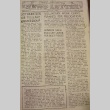
doc
Puyallup Camp Harmony News-Letter Vol. I No. 4 (May 23, 1942) (ddr-densho-194-4)
Selected article titles: "200 Volunteer for Tulelake Advance Group" (p. 1), "Wanted: A Name to Replace the News-Letter" (p. 1), "Voluntary Work Corps... Planned for Relocation..." (p. 1), "Growers Seek Evacuee Labor for Beet Fields" (p. 1), "No Information So Far On Self Relocation" (p. 3).
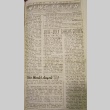
doc
Puyallup Camp Harmony News-Letter Vol. I No. 11 (August 1, 1942) (ddr-densho-194-11)
Selected article titles: "Model Plane Enthusiasts Await Wood" (p. 1), "Red Cross Visitors Tour Camp" (p. 1), "June-July Checks Coming. New Payroll Totals $24,000" (p. 1), "Hospital Comes Into Own Center Doctors Operate Twice" (p. 3), "Garment Menders Sought" (p. 4).
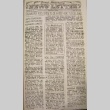
doc
Puyallup Camp Harmony News-Letter Vol. I No. 6 (June 12, 1942) (ddr-densho-194-6)
Selected article titles: "Harmony Residents Slated for Tulelake" (p. 1), "Sac'to Evacuees Leave for Tulelake Beginning June 15" (p. 1), "Applications for Relocation Being Accepted... Ito. Must Meet Certain Requirements to Qualify" (p. 2), "Early Student Relocation Seen as Plans are Formulated... W.R.A. to Take Charge of Transfers" (p. 2).
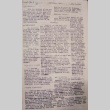
doc
Puyallup Camp Harmony News-Letter Vol. I No. 2 (May 7, 1942) (ddr-densho-194-2)
Selected article titles: "Area Grows..." (p. 3), "Women's Sanitation" (p. 3).
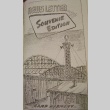
doc
Puyallup Camp Harmony News-Letter Vol. I No. 12 (August 14, 1942) (ddr-densho-194-12)
Selected article titles: "Minidoka Previewed" (p. 2), "What Makes This Center Run? J.J. McGovern, Gentleman Farmer" (p. 2), "Editorial: Our Coming Home by James Sakamoto" (p. 10).
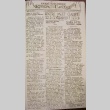
doc
Puyallup Camp Harmony News-Letter Vol. I No. 3 (May 14, 1942) (ddr-densho-194-3)
Selected article titles: "Wages of Evacuees Between $8-$16 Monthly" (p. 1), "Youngest Evacuee Will be Three-Week Old" (p. 1), "Joy Hikes Between Areas Scored" (p. 1), "Bachelors Will Remain in Present Quarters Till Monday" (p. 2).
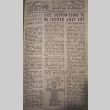
doc
Puyallup Camp Harmony News-Letter Vol. I No. 8 (June 25, 1942) (ddr-densho-194-8)
Selected article titles: "Students' Relocation Forms OK'd" (p. 1), "Daily Roll Call Reduced to One" (p. 1), "Sumo Matches Staged" (p. 2), "364 Youths in 18-20 Group Face New Draft" (p. 3), "Inter-Area Visits OK'd" (p. 3), "Army Mum on Removal Date" (p. 3), "Carving Names Becomes Favorite Camp Diversion" (p. 4).
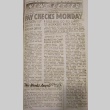
doc
Puyallup Camp Harmony News-Letter Vol. I No. 10 (July 16, 1942) (ddr-densho-194-10)
Selected article titles: "Pay Checks Monday. $9,150 Will Go to 2,400... 'D' Workers First Payees" (p. 1), "M'Govern 1st Donor for Plasma Drive" (p. 1), "Japanese Print Banned in Camp, Bibles Exempt..." (p. 1), "Editorial: 'Nothing is Useless'" (p. 2), "Canteen Prices Reduced" (p. 2), "Fats and Oils to Grease War Effort" (p. 2), "Camp Readied …
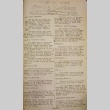
doc
Puyallup Camp Harmony News-Letter Vol. I No. 1 (May 5, 1942) (ddr-densho-194-1)
Selected article titles: "Med. Exams Completed" (p. 1), "Laundry Facilities Ready" (p. 1), "Letters to Outside Friends" (p. 1), "Bring in Those Tools..." (p. 2).
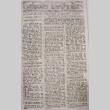
doc
Puyallup Camp Harmony News-Letter Vol. I No. 5 (June 2, 1942) (ddr-densho-194-5)
Selected article titles: "Hayashi's Miks Organized Into Camp Orchestra" (p. 1), "Continued-Contest for New Name!" (p. 1), "Tulelake Advance Crew Reports Conditions Good" (p. 1), "Relocation Sign Up Unofficial Move" (p. 1), "Typhoid Shot Notice Given" (p. 1), "Bulletin From Tulelake Claims Valley Fertile" (p. 2), "Program Planned for Recreation for Issei, Nisei" (p. 2).
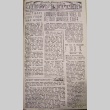
doc
Puyallup Camp Harmony News-Letter Vol. I No. 7 (June 17, 1942) (ddr-densho-194-7)
Selected article titles: "Pact Bars Issei from War Work" (p. 1), "Landslide Majority Votes to Retain Japanese Staff..." (p. 1), "Map of Tulelake Community" (p. 3).
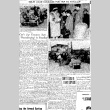
doc
Exiles Load Luggage for Trip to Puyallup. City's Jap Evacuees Start 'Housekeeping' in Puyallup (April 28, 1942) (ddr-densho-56-777)
The Seattle Daily Times, April 28, 1942, p. 5
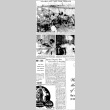
doc
Japanese Organize Own Government at Puyallup (May 6, 1942) (ddr-densho-56-787)
The Seattle Daily Times, May 6, 1942, p. 20
